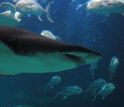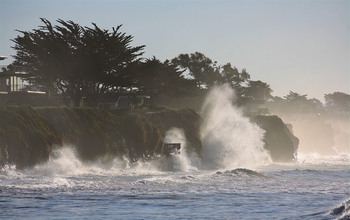
Research News
With shark attacks, or bites, in the news, what’s the story behind the story?
July 27, 2015
Danger: shark attack (or more properly, say scientists, shark bite). With sharks swimming ever closer to shore this summer–or seeming to–and crossing paths with surfers and bathers, what’s going on?
To learn what motivates a shark, the National Science Foundation (NSF) talked with two grantees who are shark biologists: Nick Whitney of the Mote Marine Laboratory in Sarasota, Fla., and Gavin Naylor of the College of Charleston in Charleston, S.C. Whitney’s research is funded by NSF’s Division of Ocean Sciences; Naylor’s by NSF’s Division of Environmental Biology.
1) With shark attacks–or bites, as scientists call them–frequently in the news this summer, are there more sharks in coastal regions and if so, why?
(Naylor) Different species of sharks target different prey, so it may simply be that their prey is closer in, where people are swimming.
(Whitney) There have been an unusually high number of shark bites in North Carolina this summer, but the number of bites in other areas is down or in line with typical summers. Many of these are investigatory bites that involve the shark releasing the person and swimming away after the initial bite. The vast majority of shark-bite victims survive the incident, often with surprisingly minor injuries. That would not be the case if each incident were truly an “attack.”
2) What brings sharks closer to shore?
(Naylor) Water temperature, food supply and occasionally reproductive condition (some sharks come in to drop their pups).
(Whitney) When schools of bait fish come near shore, they often draw in larger fish and sharks. Some telltale signs include small fish near the surface, or large numbers of seabirds diving into the water to feed. It’s a good idea to stay out of these areas.
3) Popular wisdom claims that shark attacks on humans are cases of mistaken identity–the shark thinks a person is its usual seal or other prey. Is that the case?
(Naylor) This is likely the case in most instances, but in a few cases it might simply be curiosity.
(Whitney) Sharks don’t have hands to touch something and investigate it. They do that with their teeth, and are surprisingly dexterous with their mouths. They are capable of biting each other during mating without seriously injuring each other, and of biting potential prey items in an investigatory manner without going for the kill. The fact that most shark bite victims survive with relatively minor injuries is evidence.
4) It’s said that sharks need to keep swimming to stay alive. Is there any truth to that?
(Naylor) This is certainly true for most active pelagic sharks. Water is forced over their gills as they move. However, there are several groups of sharks that can pump water over their gills when stationary, such as walking sharks and nurse sharks.
(Whitney) Many shark species that must swim to breathe are capable of lying still and breathing for short periods in times of stress or during mating.
5) Sharks may have traits that make them important in medical research. Can you elaborate?
(Naylor) It’s possible that sharks, like many organisms that have not been extensively studied, have traits that are important for medical research. Shark skin, for example, appears to have antibacterial properties.
(Whitney) Researchers at Mote Marine Laboratory have been some of the world leaders in the study of how shark immune systems can potentially benefit humans. They’ve isolated compounds from shark organs that inhibit the growth of tumor cells. They’re also studying how antimicrobial properties in stingrays can be used to develop new antibiotics to combat the increasing number of drug-resistant bacterial strains.
6) What are we learning about the evolution of sharks?
(Naylor) One thing that is especially interesting is that Lamniform sharks (like white sharks, makos and threshers) belong to an ancient group that didn’t diversify as much as their counterparts.
(Whitney) Something that has always fascinated me about sharks is their amazing diversity and ability to defy simple classification. The whitetip reef shark was initially classified in one family (Triakidae) based on its teeth and its habit of resting on the bottom, but has since been deemed a Carcharhinid. As such, it is the only Carcharhinid that rests on the bottom and has three-pointed teeth. It’s fantastic to have molecular techniques available now that can give us much greater insights.
7) How often does a shark need to eat, and what can scientific research tell us about how sharks use energy?
(Whitney) Sharks are opportunistic predators, but the old idea that they will never turn down an easy meal is false. That’s great news for surfers, but makes it difficult to study them when you first have to catch them on a baited hook! The study of shark-feeding was traditionally done only through examining the stomach contents of dead animals. Today, scientists are using new sensors and devices to try to understand how often sharks need to feed and what their average meal size is. Some species may stop feeding during their mating season. Sharks held in captivity sometimes cease eating for weeks at a time–with no explanation. It’s amazing how much we still don’t know about basic aspects of shark behavior.
8) How fast and how far do sharks swim?
(Whitney) How fast sharks swim is something that is very rarely studied. Even satellite-tracking technology only shows us how quickly an animal is covering ground. In white sharks that’s typically about 2 to3 miles per hour, but that’s not the same as how fast they’re actually swimming because their paths are rarely straight lines. Sophisticated tag sensors have shown that mako sharks can swim more than 40 miles per hour for short bursts. Species like white sharks are capable of swimming thousands of miles and crossing ocean basins, whereas smaller reef sharks may return to the same “resting cave” or coral head for weeks, months or even years.
9) Are shark populations in decline on a global basis, and what can we do about it?
(Naylor) Populations of some species of sharks have declined precipitously. Some seemingly rare sharks, like the pocket shark, Mollisquama parini, are only known from two specimens. It’s possible that some of these rare animals are not threatened, but are just not encountered by scientists because the sharks live in inaccessible habitats such as the deep ocean.
(Whitney) Most shark species are long-lived, slow-growing and slow to reproduce. That makes them vulnerable to fishing pressure. Once reproductively active adults are removed from a population, it can take years or even decades for the remaining animals to grow large enough to start slowly rebuilding the population. Shark fisheries are therefore “boom and bust” fisheries that collapse after a few years of exploitation. However, some shark species can be fished sustainably when properly managed. With a few exceptions, shark fisheries in U.S. waters today are well regulated, and populations are rebounding. The most severe exploitation of sharks is now taking place overseas and in developing nations, which makes shark conservation a multinational endeavor.
10) What would the oceans be like without sharks, apex predators of the seas?
(Naylor) It’s safe to say that the oceans would be very different without sharks. It’s likely that a new steady state would arise. Certain fish that are regularly kept in check by sharks might increase, putting pressure on other food sources. Removal of apex predators like sharks can reverberate right down to phytoplankton and bacteria.
(Whitney) Areas with healthy shark populations tend to have healthier and more diverse fish populations. When sharks are removed, the consequences can be dire for species down the food chain, even if sharks don’t feed on them directly. Healthy shark populations make for healthy oceans.
—
Cheryl Dybas,
NSF
(703) 292-7734 cdybas@nsf.gov
-
(Safely) up close and personal with a shark at an aquarium.
Credit and Larger Version -
Tubbataha sharks patrol ocean waters in the Philippines.
Credit and Larger Version -
Blue sharks inhabit the cooler deep waters of the world’s temperate and tropical oceans.
Credit and Larger Version -
The basking shark is an open-mouthed plankton-feeder, “straining” its food from the water.
Credit and Larger Version -
Sand tiger sharks live along continental shelves, from sandy shorelines to deeper reefs.
Credit and Larger Version
Investigators
Gavin Naylor
Robert Hueter
Nicholas Whitney
Related Institutions/Organizations
College of Charleston
Mote Marine Laboratory
Related Awards
#1156141 Collaborative Research: Determining the Field Metabolic Rate of Marine Predators: Integrating Accelerometry and Respirometry to Bridge the Gap Between the Laboratory and the Field
#1132229 Collaborative Research: Jaws and Backbone: Chondrichthyan Phylogeny and a Spine for the Vertebrate Tree of Life
Total Grants
$2,892,019
Source: NSF News
Brought to you by China News












